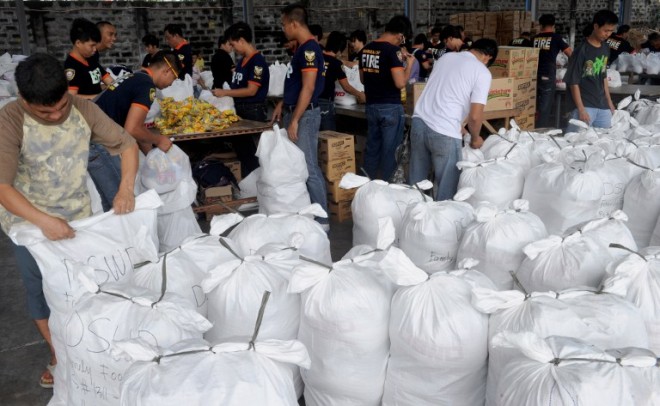
Since relief operations began in Eastern Visayas, some 500,000 food packs have been distributed by the Department of Social Welfare and Development (DSWD) to survivors of Supertyphoon “Yolanda.” President Aquino, however, is unsatisfied with that number, noting that 1.4 million people have to be fed by the government for some time.. AFP FILE PHOTO
TACLOBAN CITY, Philippines—Since relief operations began in Eastern Visayas, some 500,000 food packs have been distributed by the Department of Social Welfare and Development (DSWD) to survivors of Supertyphoon “Yolanda.”
President Aquino, however, is unsatisfied with that number, noting that 1.4 million people have to be fed by the government for some time, unless it provides livelihood to them under its “cash-for-work” or “food-for-work” program.
“[Some] 1.4 million have to be fed every day, and that translates to 275,000 families, and just transporting all of the supplies to this area and getting them [to the victims] is a challenge,” the President told reporters here on Monday.
At the daily interagency meeting of Task Force Yolanda, Social Welfare Secretary Corazon Soliman said the total number of food packs that had been distributed since Nov. 9 was 524,147 “against the total number of 275,000 [families].”
The relief goods were given out in Leyte, Eastern and Western Samar, and Tacloban City, Soliman said.
“With additional trucks, [relief efforts] can be expedited,” she said.
‘Rice brigade’
To fill gaps in relief distribution, Soliman vowed to increase the frequency and reach of the “[rice] brigade,” a much faster system that entails no more than dropping off 60 sacks of rice to municipal centers every day.
The belated solution to the logjam in moving relief goods, mainly consisting of rice and other food items, came as the main warehouse of the National Food Authority (NFA) here is already overflowing with sacks of rice bought by the government and other relief goods coming from international donors such as USAID.
The rice brigade, started on Nov. 14, has covered the 24 towns of Leyte province, delivering 47,137 “equivalent food packs,” Soliman said.
President Aquino asked to be taken to the NFA warehouse late Sunday, and may have personally confirmed what was obvious to everyone here—the government had enough relief stocks.
More are coming, but too little are reaching the survivors.
Delivering the goods
On Monday, Aquino himself took some of the goods to Palo and Alangalang towns in Leyte.
From the Palo municipal hall, he made a side trip to the nearby public market, buying 6 kilos of fish.
He later proceeded to the adjoining town of Alangalang, where he led the ceremonial distribution of 60 sacks of food packs and 30 tarp sheets for tents.
Aquino assured the typhoon survivors that more help was on the way.
Under the blistering heat of the midday sun, residents gathered around the town hall’s perimeter fence, complaining to reporters that aid had been too little and far between.
A 27-year-old man said that since the typhoon, military choppers dropped a total of 60 sacks of food packs to two evacuation centers in the town of 80,000 people.
The last distribution of food packs was on Saturday, he said.
“We ran out of rice during the weekend. We have nothing to eat anymore,” he said.
Some 20 steps away, the President was fielding questions from reporters.
Ultimately responsible
“I’m the Chief Executive, therefore everything that happens I’m ultimately responsible,” he said, but again pointed out that distributing relief goods to far-flung areas was a challenge.
He also retreated to his now familiar line that compared to other provinces in the Visayas, the Leyte-Samar area had the biggest number of casualties.
In an interview in Tacloban City on Sunday, Aquino said that in Leyte alone, 40 towns and three cities had to be attended to by relief workers.
“And, of course, we have a lot of islands. But at least the main roads have been cleared. We have to generate more efficiency in terms of the loading and unloading from ports in Luzon to unloading here, and to also to distribution [points],” he said.
RELATED STORIES:
Aquino in Leyte to oversee relief efforts
No aid? Aquino points to local execs